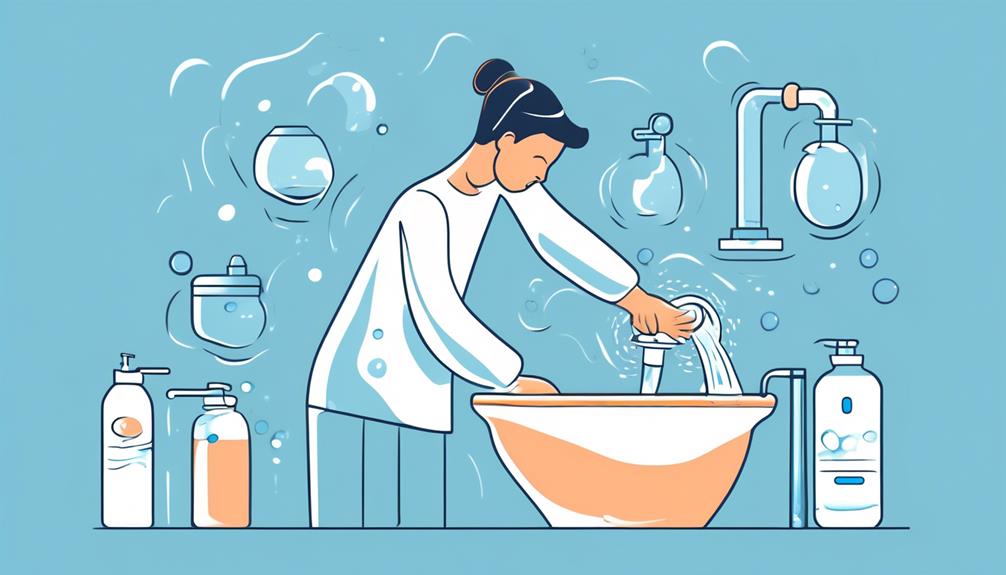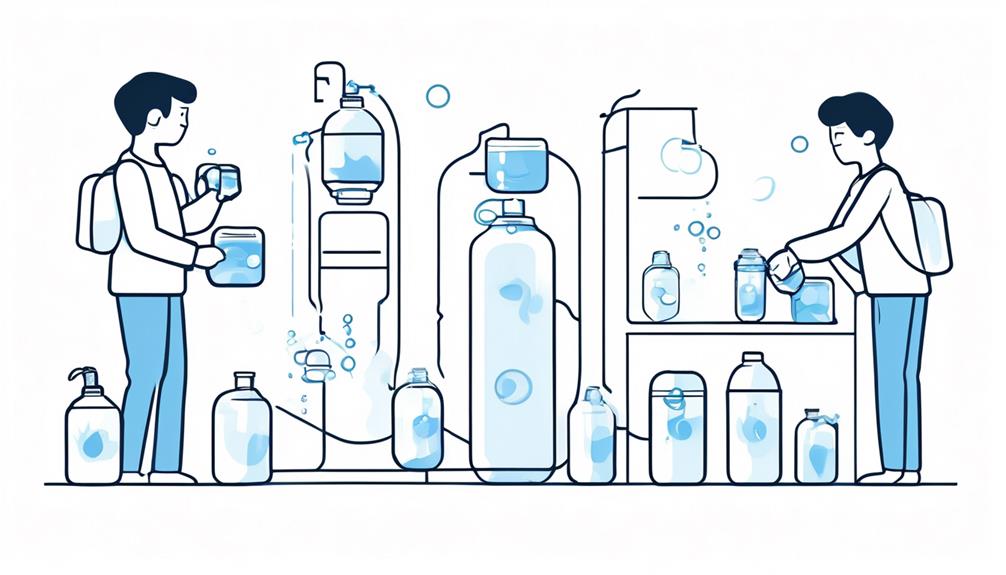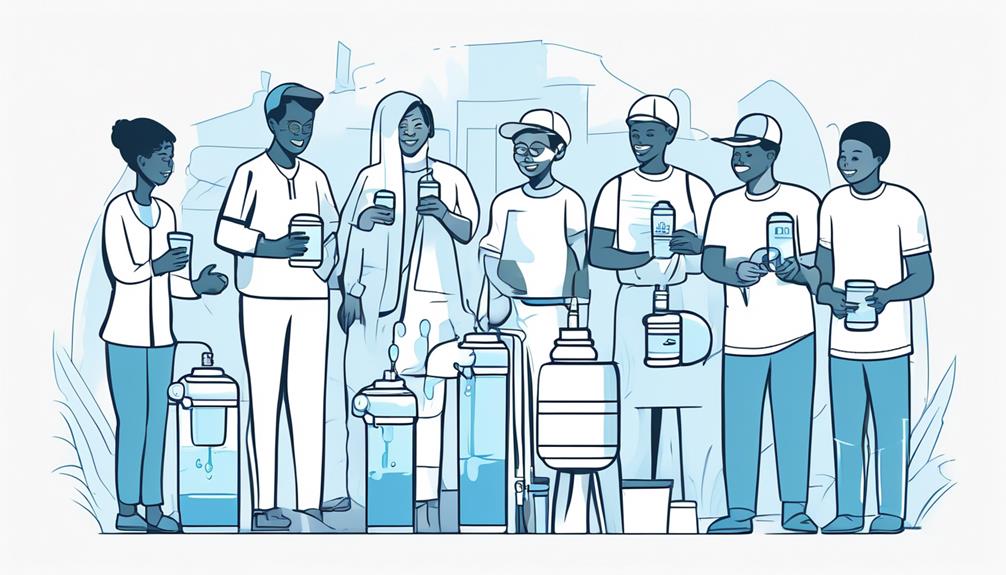When it comes to preventing waterborne diseases, the old adage 'prevention is better than cure' holds true. Water is essential for life, but if not handled correctly, it can also be a source of harmful diseases.
You might think that just drinking clean water is enough, but there's more to it than meets the eye. By following six essential tips, you can safeguard yourself and your loved ones from the dangers lurking in contaminated water.
From simple daily habits to community-wide initiatives, these tips could make a significant difference in your health and well-being.
Key Takeaways
- Recognize symptoms of waterborne diseases for early prevention
- Understand sources of water contamination to take proactive measures
- Access clean water and hygiene education are crucial for disease prevention
- Community efforts play a significant role in protecting against waterborne diseases
Importance of Educational Programs
Educational programs play a crucial role in equipping communities with the knowledge and skills needed to prevent waterborne diseases effectively. By providing information on proper sanitation practices, water treatment methods, and personal hygiene, these programs empower individuals to protect themselves and their families from harmful pathogens present in contaminated water sources.
Through workshops, seminars, and outreach initiatives, communities can learn about the importance of clean water and the dangers of waterborne illnesses.
Additionally, educational programs raise awareness about common sources of water contamination, such as sewage leaks, agricultural runoff, and inadequate wastewater treatment. By understanding how water can become polluted, individuals can take proactive measures to safeguard their water supply and prevent the spread of diseases like cholera, typhoid, and dysentery.
Moreover, these programs teach community members how to recognize the symptoms of waterborne illnesses and seek timely medical assistance when needed.
Understanding Waterborne Diseases
Now that you grasp the importance of educational programs in preventing waterborne diseases, let's dive into understanding the various types of waterborne illnesses and how they can affect communities.
Waterborne diseases are caused by pathogenic microorganisms that are transmitted through contaminated water sources. These diseases can include cholera, typhoid fever, dysentery, and hepatitis A.
Cholera is known for causing severe diarrhea and dehydration, leading to rapid health deterioration if left untreated. Typhoid fever results in prolonged fever, weakness, and abdominal pain. Dysentery manifests as bloody diarrhea and can be life-threatening, especially in young children and the elderly. Hepatitis A affects the liver and can cause jaundice and flu-like symptoms.
Understanding waterborne diseases is crucial for implementing effective prevention strategies, such as ensuring access to clean drinking water, proper sanitation practices, and promoting hygiene education. By recognizing the symptoms and transmission routes of these illnesses, communities can work together to safeguard against waterborne diseases and protect public health.
Sources of Water Contamination
Hey there!
Let's talk about the sources of water contamination.
Understanding what common contaminants are found, how they impact health, and the preventative measures you can take are essential in keeping water safe.
Common Contaminants Found
When it comes to water contamination, various common contaminants can be found that pose risks to human health and the environment. Here are some sources of water contamination to be aware of:
- Microorganisms:
- Bacteria like E. coli and Salmonella.
- Parasites such as Giardia and Cryptosporidium.
- Chemical Pollutants:
- Heavy metals like lead and mercury.
- Pesticides and herbicides.
Being mindful of these common contaminants can help you take steps to protect yourself and your community from waterborne diseases. Remember to stay informed and proactive in safeguarding the quality of your water sources.
Impact on Health
Understanding the impact of water contamination on health is crucial in recognizing the sources that can compromise the safety of our water sources. Various contaminants can infiltrate our water systems, posing serious health risks. Here is a breakdown of common sources of water contamination and their potential health impacts:
| Contaminant | Source | Health Impact |
|---|---|---|
| Bacteria | Sewage, Animal Waste | Gastrointestinal illnesses |
| Heavy Metals | Industrial Discharges | Developmental issues, Organ damage |
| Pesticides | Agriculture Runoff | Neurological problems, Cancer risk |
Preventative Measures
To effectively prevent water contamination, understanding the sources of pollution is essential. When it comes to sources of water contamination, it's crucial to be aware of both natural and human-made factors that can compromise water quality. Here are some key points to consider:
- Natural Sources:
- Groundwater: Contaminants from underground can seep into water sources.
- Surface Water: Runoff from rain or snowmelt can carry pollutants into rivers and lakes.
- Human-Made Sources:
- Industrial Activities: Discharge from factories can introduce harmful chemicals.
- Agricultural Practices: Pesticides and fertilizers can leach into water bodies, affecting water quality.
Impact on Public Health

When water is contaminated, it poses serious risks to your health. Clean water is essential for preventing waterborne diseases and maintaining public health.
There are various strategies you can implement to ensure water safety and protect yourself and your community.
Health Risks of Contaminated Water
Contaminated water poses significant health risks to communities, jeopardizing the well-being of individuals and public health overall. When water sources are contaminated, the consequences can be severe. Consider the following points:
- Immediate Health Impacts:
- Diarrheal diseases like cholera and typhoid can spread rapidly.
- Skin infections and respiratory problems may arise from contact with contaminated water.
- Long-Term Health Effects:
- Chronic conditions such as liver damage and certain cancers could develop.
- Children and the elderly are particularly vulnerable to the long-lasting effects of consuming contaminated water.
Importance of Clean Water
Considering the critical role water plays in maintaining public health, ensuring access to clean water is paramount for preventing waterborne diseases and safeguarding community well-being.
Clean water is essential for drinking, cooking, sanitation, and hygiene practices. Contaminated water can harbor harmful pathogens like bacteria, viruses, and parasites, leading to a range of illnesses such as diarrhea, cholera, and typhoid fever.
By prioritizing clean water sources and implementing proper water treatment methods, the risk of waterborne diseases can be significantly reduced. Access to clean water not only promotes physical health but also contributes to overall community prosperity by preventing outbreaks, reducing healthcare costs, and improving quality of life.
Strategies for Prevention
To prevent waterborne diseases and protect public health, implementing effective strategies is crucial. Here are some key strategies you can adopt:
- Water Treatment:
- Ensure proper disinfection methods like chlorination to kill harmful pathogens.
- Regularly monitor water quality to detect any contamination early.
- Sanitation Practices:
- Promote handwashing with clean water and soap to prevent the spread of waterborne illnesses.
- Properly dispose of waste to avoid contaminating water sources.
Implementing Preventive Measures

When addressing preventive measures for waterborne diseases, cleanliness plays a crucial role in safeguarding your health. Ensuring that your water sources are clean and free from contamination is essential. Regularly sanitize water storage containers, wells, and pipes to prevent harmful pathogens from thriving. Additionally, always wash your hands with soap and clean water before handling food or eating to avoid ingesting any harmful microorganisms.
Proper hygiene practices extend beyond just water sources. Keep your surroundings clean to prevent stagnant water, which can serve as breeding grounds for disease-carrying mosquitoes. Dispose of waste properly to avoid contaminating water sources and causing the spread of waterborne illnesses.
Furthermore, it's vital to invest in water filtration systems or water purification tablets to further reduce the risk of waterborne diseases. These tools can effectively remove harmful bacteria and parasites, ensuring that the water you consume is safe for your health.
Training on Water Treatment
For effective prevention of waterborne diseases, understanding and implementing proper training on water treatment is essential to ensure the safety of your water sources.
When it comes to training on water treatment, there are a few key points to consider:
- Knowledge:
- Understand the basics of water treatment processes such as filtration, disinfection, and purification methods.
- Practical Skills:
- Learn how to operate water treatment equipment correctly and safely.
Community Awareness Initiatives

Engage your community with informative initiatives to raise awareness about waterborne diseases and prevention methods. Community awareness is key to preventing waterborne diseases. By educating your community about the risks and how to prevent them, you empower individuals to take proactive steps towards better health. Here are some effective ways to implement community awareness initiatives:
| Initiative | Description | Benefits |
|---|---|---|
| Workshops | Conduct interactive workshops on waterborne diseases | Enhances knowledge and promotes discussions |
| Information Sessions | Host sessions to share prevention methods | Increases understanding and encourages action |
| Awareness Campaigns | Organize campaigns using posters, flyers, and social media | Reaches a wider audience and creates impact |
Partnerships for Effective Education
To maximize educational impact, fostering strategic alliances is crucial for addressing waterborne diseases effectively. By partnering with various organizations and stakeholders, you can create a more comprehensive approach to educate communities about the importance of clean water and sanitation practices. Here's how partnerships can enhance your educational efforts:
- Leverage Diverse Expertise:
Collaborate with local health authorities, NGOs, and educational institutions to access a wide range of expertise in public health, community engagement, and water management.
- Expand Outreach:
Join forces with media outlets, social influencers, and community leaders to reach a larger audience and disseminate crucial information on waterborne diseases prevention.
Through strategic partnerships, you can amplify your educational initiatives, tailor messages to specific audiences, and foster a culture of awareness and action against waterborne diseases. By working together, you can make a significant impact on promoting healthier communities and reducing the prevalence of waterborne illnesses.
Frequently Asked Questions
How Can Individuals in Rural Communities Access Clean Drinking Water if They Do Not Have Access to Treated Water Sources?
If you lack access to treated water, you can safeguard your health by boiling water before use, or using water purification tablets. Collect rainwater or install a simple filtration system for a safer supply.
Are There Any Specific Waterborne Diseases That Are More Common in Certain Regions or Climates?
In certain regions or climates, specific waterborne diseases like cholera, typhoid fever, and hepatitis A are more common. Understanding these regional risks can help you take necessary precautions to protect yourself and your loved ones.
What Are Some Innovative Technologies Being Used to Improve Water Treatment and Prevent Waterborne Diseases?
Innovative technologies like UV radiation and advanced filtration systems are revolutionizing water treatment. These methods kill harmful microorganisms, ensuring safer drinking water. Stay informed about these advancements to protect your health and prevent waterborne diseases effectively.
How Can Individuals Living in Developing Countries Contribute to Preventing Waterborne Diseases Without Access to Advanced Water Treatment Systems?
To prevent waterborne diseases without advanced systems, you can boil water before use, purify with chlorine tablets, filter with cloth, wash hands regularly, use latrines, and protect water sources. Simple actions make a big difference.
Are There Any Natural Remedies or Alternative Methods to Prevent Waterborne Diseases Aside From Traditional Water Treatment Methods?
When seeking natural remedies, explore options like boiling water, using sunlight to disinfect, or adding chlorine bleach. These methods, though simple, can help prevent waterborne diseases by killing harmful pathogens.
Conclusion
In conclusion, remember that prevention is better than cure when it comes to waterborne diseases. By staying informed, taking proactive steps to protect your water sources, and participating in community education programs, you can help keep yourself and your loved ones safe from harmful contaminants.
As the saying goes, 'An ounce of prevention is worth a pound of cure.' Stay vigilant and prioritize healthy water practices to safeguard your health and well-being.
